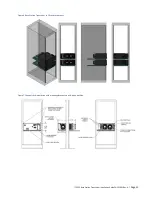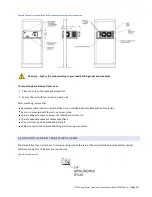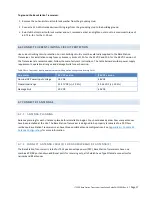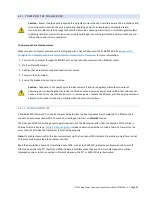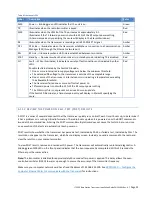
ITC 220 Base Station Transceiver Installation Guide PN 133991 Rev. A
| Page 9
4
BASE TRANSMITTER OPERATION
It is the responsibility of the licensee to operate this radio transmitter in compliance with FCC and Industry Canada
service rules for 220-222 MHz, namely FCC Rules Part 90 Subpart T and Industry Canada SRSP-512.
4.1
BASE STATION TRANSCEIVER CHANNELIZATION AND FREQUENCY RANGE
The Base Station Transceiver can be configured to transmit on any one of 80 selectable 25 kHz spaced channels ranging
from 220.0125 to 221.9875 MHz inclusive. The spectrum included corresponds to all 5 kHz-wide FCC channels
numbered from 1 at 220.0025 MHz to 400 at 221.9975 MHz. Each Base Station transmission occupies five of the FCC-
defined 5 kHz channels. The lowest radio channel center frequency is in the center of FCC channel 3 and the next is
centered on FCC channel 8, then 13, 18, and so on, up to the highest, which is centered with FCC channel 398.
4.2
BASE CHANNEL RESTRICTIONS
Section 90.715 of the FCC Rules lists the authorized frequencies of the 400 total 5 kHz wide channels. According to
§90.733(d), these can be aggregated into larger channel widths with the exceptions of FCC channels 161-170 and 181-
185. Therefore, the radio may not transmit on those channels or their 221 MHz counterparts, 361-370 and 381-385.
This corresponds to frequencies 220.8125, 220.8375, 220.9125, 221.8125, 221.8375, and 221.9125 MHz.
Please refer to Part 90 Subpart T and SRSP-512 for additional frequency use restrictions in Canadian and Mexican
border areas.
4.3
BASE-RADIATED POWER LIMITS
It is the responsibility of the licensee to comply with the effective radiated power limits based on operating
frequency, geographic location, and effective antenna height specified in 47CFR Subpart T §90.701 et. seq.,
or Industry Canada SRSP-512 §6.3, as applicable.
Important:
The following supplementary antenna system information discusses means for the licensee to determine
effective radiated power (ERP) and to comply with regulatory power limits.
Licensees must comply with specific power vs. HAAT limitations for fixed-base stations unless operating under an
explicit waiver of the applicable rule. U.S. and Canadian power limits differ in this regard.
Licensees should also note that fixed installations transmitting between 221 and 222 MHz must limit effective radiated
power (ERP) to 50 W or 10log(50) + 30 = 47 dBm PEP referenced to the 2.15 dBi gain of a dipole. The EIRP for this case
is 49.15 dBm. Also note that the maximum ERP on FCC/IC channels 196-200 at 220.975 to 221.000 MHz is 2 watts.
Common single element fixed station antennas typically exhibit 2.1 to 5 dBi (0 to 2.9 dBd) gain and being vertically
polarized, are usually omnidirectional. Multi-element antennas are designed to concentrate RF radiated power toward
the horizon and away from the sky and the earth and, depending on the design criteria, provide azimuthal gain
directivity that decreases ERP in the direction of other base stations or increases ERP in a specific direction. They may
also be used to make up for large losses between transmitter and antenna. The isotropic gain of a commonly-used two-
element exposed dipole antenna is typically 7 to 8 dBi.
Once the allowable ERP is determined by applying all power-restrictive rules from above and the antenna gain is
known, the transmitter peak envelope power (PEP) output feeding the transmission line is determined by subtracting
the antenna gain in dBi from the EIRP and adding the loss from the antenna feedline and connectors plus the loss from
any combiners, cavity filters or lightning arresters. If the net value is greater than or equal to 48.75 dBm, then the 75 W





















